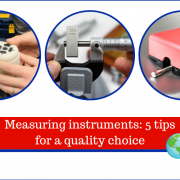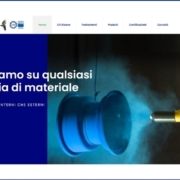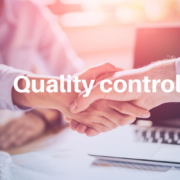Roughness Measure and Control: A Definitive Guide
Roughness measure and control is a very important aspect to guarantee surface quality. It may seem to be a smooth flat surface, but it’s never 100% flat. This means surface roughness is never a value of zero. But, what is surface roughness?
What is surface roughness?
Surface roughness refers to the irregularities that appear on the surface of a piece as a result of mechanical processes such as milling, turning and grinding.
So, even the smoothest surface to the touch or flattest surface to the eye will have peaks and valleys that must be measured and controlled to make sure the desired surface finish is achieved.
Why is roughness measure and control so important?
Measuring and controlling the roughness of the surface is important because it can have a significant impact on different aspects of the piece, including:
- The look and feel of the surface.
- The functionality of the surface.
- The adherence of any kind of coating on the surface.
Rotating machinery represent a good example to illustrate this importance. There are moving parts that require specific roughness for their proper operation.
If the roughness is too high, it may result in accelerated failure because of increased wear, while a roughness value below the requirements may result in loose parts that could affect machine operation.
How to measure surface roughness?
Surface roughness is usually measured by means of a probe that is commonly called a surface roughness profiler. This name is given to the probe because it moves in a straight line over an evaluation length selected on the surface and creates a profile of the irregularities found on such surface.
The profile created is composed of peaks and valleys, and the roughness parameters are calculated based on the height of those peaks and the depth of those valleys.
The parameters of roughness
One of the most common ways to represent surface roughness is with the average roughness or “Ra”. The average roughness (Ra) is defined as the arithmetic average value of the absolute values within an evaluation length.
In other words, the value of Ra shows an average value of how much the profile moves up or down from an imaginary line that represents what is considered completely flat. This information means that larger values of Ra represent a higher roughness of the surface.
Here is some more information about roughness parameters.
However, measuring and controlling the average roughness (Ra) of the surface alone may not always be enough, as it has some limitations. For example, an Ra value does not make a difference for the type of irregularity. This makes it necessary to measure and control other roughness parameters, such as:
- RPc to characterize a profile, which means counting the peaks.
- The mean square roughness (Rq), which is the square root of the mean of deviations squares of the real profile within an evaluation length.
- Rz, commonly used in sandblasting and which takes into account the average peak-valley difference of 10 points (5 peaks and 5 valleys) that deviate more within an evaluation length.
- Rmax, which allows measuring the maximum depth of profile within an evaluation length.
Fortunately, all these values are not calculated by hand any more. Tools like our graphic roughness tester will do the job with high accuracy and without complications.

Take a look at the video of graphic roughness tester
What are the applications of roughness measure and control?
As described above, surface roughness can have an impact on different aspects of a piece. Therefore, it is common to see roughness measure and control applications which need to reduce such an impact.
Some examples of surface roughness measure and control include:

- Automotive parts where controlling the friction is important, like in the case of brake and clutch systems.
- Equipment for pharmaceutical and food processing, since they require low values of roughness to avoid particles to adhere on the surfaces of vessels and other elements to avoid contamination between batches.
- Flooring preparation to avoid slippery surfaces in places like hospitals and other areas where a higher roughness on the floor surface is required.
- Electronics and semiconductors for a better operation.
- Machine tools production, especially those used for high-precision manufacturing such as gear cutting tools.
- Hydraulic and pneumatic actuators, where avoiding the increase of friction is essential for proper operation.
- Paper manufacturing industry.
- Medical equipment.
- Telescopic tubes.
- Clothing manufacturing machinery.
- Ceramics and porcelains.
- Bearings, couplings and seals.
- Casting molds and other casting equipment that require high precision surfaces.
- Valves, pumps and other machinery.
One can easily see that many different industries can benefit from roughness measurement and control.
Moreover, it’s important to highlight that measuring and controlling surface roughness is an important step both in production and in quality assurance (QA) and quality control (QC) in the laboratory.
Sometimes, pieces need to be processed in-line or on the field, and therefore measurements are needed outside the laboratory.
For those cases, our compact surface roughness tester and portable surface roughness tester definitely come in handy.

How to select a surface roughness measure and control tool?
Purchasing a surface roughness measure and control tool is very important, and it is also important to select the best option for the application at hand. There are different aspects that require consideration when selecting the right tool. The most relevant are:
- Whether the specific values of the parameters are required or just a comparison is needed.
- The number of parameters that need to be measured.
- The need for a visualization of the profile.
- The need for portability.
- The need for a specific application such as coating after sandblasting.
Roughness meter calibration
The calibration report with reference to primary samples is carried out by using LAT certified specimens whose roughness values Ra, Rz etc are tested with the new roughness meters, or already in customer’s possession, to identify the relative deviation.
You can rely on us for the calibration of your instruments because we are ISO 9001 certified for the provision of the calibration service.
If you want to check the roughness measure and control instruments, we offer a wide selection to choose from, just click here.
However, if you are not sure or have any doubts about measuring and controlling surface roughness, we recommend you contact us and one of our technical experts will gladly help you.













